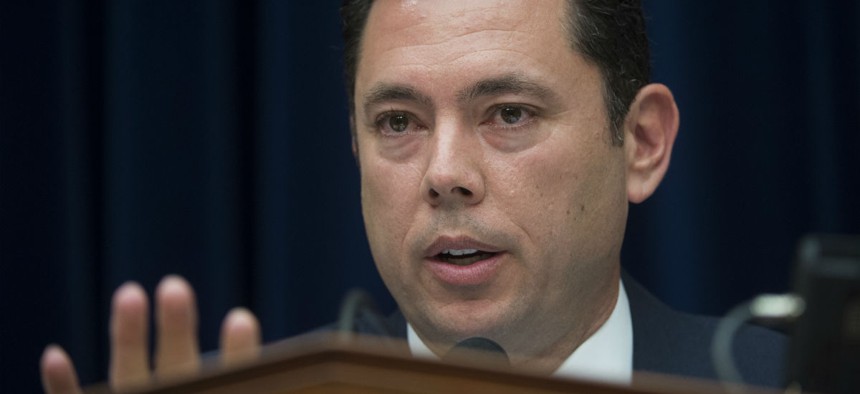
House Oversight and Government Reform Committee Chairman Rep. Jason Chaffetz, R-Utah. AP file photo
Pentagon Defends Quiet Response to Study Offering $125 Billion In Savings
House hearing shows miscommunication between the Defense Department and the Defense Business Board.
One hundred and twenty-five billion dollars is a lot of money—even in Washington.
That’s how much money the Pentagon could save over five years if only it reformed its back-office functions, according to a McKinsey & Co. study Pentagon officials last year allegedly “buried.” Lawmakers of both parties on the House Oversight panel on Tuesday demanded to know why the study wasn’t publicized.
Republicans implied the Defense Department had treated the study “differently” from other studies, “hiding” it because they feared defense cuts. Democrats highlighted the irony in ignoring such opportunities to curb waste as President Trump is proposing to add $54 billion the military budget.
Defense officials insisted that, contrary to news media reports saying the study was ignored, it was widely circulated (and reported by Defense News) and put to use to implement modest though not spectacular savings, though its presentation revealed some communication gaps with the private advisory body that commissioned the study, the Defense Business Board.
A December story by the Washington Post about the McKinsey study, first delivered in January 2015, prompted outrage on Capitol Hill—though the notion of that much administrative waste at DoD was described as “no surprise” by Armed Services panel chairmen Sen. John McCain, R-Ariz., and Rep. Mac Thornberry, R-Texas.
Thirty-one members of the House Oversight and Government Reform Committee on Dec. 8 sent a letter to then-Defense Secretary Ash Carter demanding an explanation, saying “the savings could have been significant” in such overhead areas as accounting, logistics, human resources and property management.
The long-promised hearing convened this Tuesday by Rep. Jason Chaffetz, R-Utah, was designed to “investigate any deliberate suppression of the DBB's findings, as well as DoD's progress in implementing necessary human resource and administrative cuts.”
Current and former leaders of the private Defense Business Board testified that they believed in the study, that McKinsey had done a good job, and that they personally had briefed new Defense Secretary James Mattis on its value. But none fully explained how the report was “buried” on the website.
Tapped to present the Pentagon’s side of the story—and take flak from the lawmakers—was acting Deputy Chief Management Officer David Tillotson III.
The study relied on a “corporate model” and produced “potential, but the timetable was not actionable in a federal setting,” he said. Though well-done, welcome and useful, the study did not “identify specific systems or processes that should be changed to increase the department’s productivity levels,” he testified. “Instead, the study identified metrics and benchmark levels that could be seen as efficiency goals for the department based upon similar private-sector goals.”
Tillotson gave four examples of how the study—which was discussed at the Pentagon’s highest levels and with congressional staff—“has allowed us to form the basis how to proceed going forward.” They included better identifying clear lines of business and proper headquarters activities, possibly totaling $7 billion to $8 billion worth of savings, “and we continue to build on it,” he added.
Far from being hidden, Tillotson said, the study was on the Business Board website and was downloaded 2,800 times. “There was no attempt to hide it,” he said, displaying a stack of reports. “This is the first time I‘ve heard anybody couldn’t find a copy.”
The study—which was in the control of the DBB, not Pentagon managers—at first was displayed prominently under “banner of current work.” But it was then moved to a section called “meeting minutes,” as confirmed by current board chair Michael Bayer. “I didn’t limit it in any way. By the time it was released, the board had moved on to do nine other reports” that would have replaced it under the current work section of the website, Bayer said.
Also, the study “was erroneously listed as a report, when it was a collection of slides” with little explanatory text, but with a note saying the full report was coming later,” Bayer added. “That’s why it was listed in the minutes section.”
The Pentagon’s explanation caused an explosion from Chairman Chaffetz, who said,
“It’s not a report but a slide deck. So we spent $9 million and never got a report?” he told Tillotson, accusing him of going in circles. “That’s why your department is in chaos.”
Tillotson said the DBB had put out a contract and the contractor met the deliverables, and it wasn’t the job of McKinsey to write the final report.
Robert Stein, former chairman of the DBB, said, “You had a change of secretaries and a change of board chairman, and these guys didn’t want to pursue” the report’s findings. What frustrates him, Stein said, is that “no one would get in the same room” and hash out the findings. “Having a great plan is one thing, having people to implement it is another.”
Asked whether Secretary Mattis has plans to boost use of the study, a Pentagon spokesman told Government Executive on Wednesday, “As senior leadership here in the department explained last year, the report was valuable and continues to shape the way the department is pursuing efficiencies in cross-enterprise business functions. Besides the $30 billion over the next several years we are saving, DoD recognizes and is using the information from the DBB report to pursue even more savings.”
NEXT STORY: What One Joint Chief Of Staff Thinks of Trump







